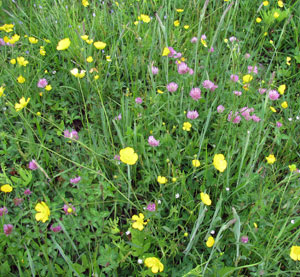Americans have a deeply rooted love affair with lawns. Stop and think about your first reaction when you see tall grass in front of a house. I don’t know about you, but I can’t help but think “that grass needs to be cut!” Some towns even have blight ordinances to address overgrown grass. The importance of an orderly, verdant lawn is embedded in our psyche. Why should it matter to me? Is it because I grew up with a father who was obsessed with having perfectly trimmed grass in our own yard? Why was manicured sod so important to him? I decided to do a little research about the history of lawns.
 |
Patches of meadows with a variety of grasses, ferns, clover and wildflowers offer habitat and food for wildlife, and don’t need to be mowed once a week. Photo by Bet Zimmerman |
I was amazed to learn that, as far back as 1915, the Dept. of Agriculture was working with the Golf Association to research types of grasses needed to create attractive lawns suited to the variety of climates found in the U.S. Eventually, they started importing grass seed from Europe and Africa.
In the past, a luxurious expanse of lawn was considered a status symbol. Only the wealthy could afford the expense of groundskeepers to maintain it with scythes and water it during dry spells. Presidents Washington, Jefferson and Wilson all used livestock to keep the grass on their estates trimmed, but that approach would not appeal to everyone.
By 1885, mass production of rotary mowers made lawns a more affordable option for the average American, although they were still not in great demand. The swiveling lawn sprinkler was patented in 1897. Then the American Garden Club stepped in. Through contests and other publicity, they convinced homeowners it was their civic duty to maintain beautiful, healthy turf.
In today's world, the importance of a green lawn persists. However, how we maintain our lawns has some surprising impacts on the environment. A few U.S. statistics that caught my attention are as follows. 1) Each year, 800 million gallons of gas are used to power lawn mowers. 2) Twenty times more pesticides are used on an acre of lawn than are used on an acre of farmland. 3) When dog owners put down four or more applications of 2,4-D per year, the risk of their dog contracting malignant lymphoma (a form of cancer) doubles. 4) Approximately one-half of residential water goes to landscaping. 5) Excess or incorrectly applied fertilizers can cause significant surface and groundwater pollution. (Sources: Green Irene Guide and Garden Club of America.) The list goes on and on, but this was enough to spark my interest in an approach to lawn care that was more environmentally friendly.
To live in better harmony with our ecosystem, one simple option to consider to reducing the area covered by your lawn. This can be most easily accomplished by expanding or adding beds for shrubs, perennials, ornamental grasses, or vegetable or herb gardens. Water gardens, rock gardens, or “hardscaping” with walkways or patios decreases the size of your lawn and adds desirable, low maintenance features to your outdoor living environment.
When mowing, raise the blade height to leave grass that is 2.5 to 3 inches tall. Let some low maintenance clover grow. Leave grass clippings where they fall. They help maintain moisture, and contain about 40 pounds of free nitrogen. (Source: Garden Club of America) As they decompose, they help foster healthy grass, but will not contribute to thatch accumulation. Use a mulching mower, or run a riding mower with the mowing deck up over the trimmed area to avoid piles of clippings. You might also want to take a step back in time and use a personally-powered reel mower and hand held trimmer. These tools save money and reduce environmental impact and noise. To top it off, the extra exercise can have a positive impact on your health and well being.
To stay green, lawns need no more than one inch of water (including rain) a week during the summer. Water in the early morning to minimize wind and evaporative losses. Deep, infrequent watering is the most efficient, promoting deeper-rooted, more resilient grass. When soil is dry or compacted, it won't absorb water quickly. If the water is puddling, stop watering for a while and then restart after the water has time to soak in. If you have a sprinkler system, make sure it’s working properly so you’re not watering the sidewalk or streets. Install a rain sensor so you don’t irrigate right after it rains. Let the soil dry between watering to prevent lawn disease.
When grass seed is needed, try the new, lower growing varieties. They need less water, nutrients and mowing to keep them looking good. Whenever possible, use organic fertilizers and pest control methods. Due to growing demand for organic approaches, you have more options than ever before.
As our love of lawn grows on, so does concern about the impact of our actions on the environment. By exploring your options to reduce that impact, you can save money, time, and natural resources while still enjoying a lovely, healthy lawn.
Pam Salois is an Independent, Authorized Green Irene Eco-Consultant. See her website at
www.greenirene.com/PamWindhamCT, or contact her at Pam.WindhamCT@greenirene.com. |

